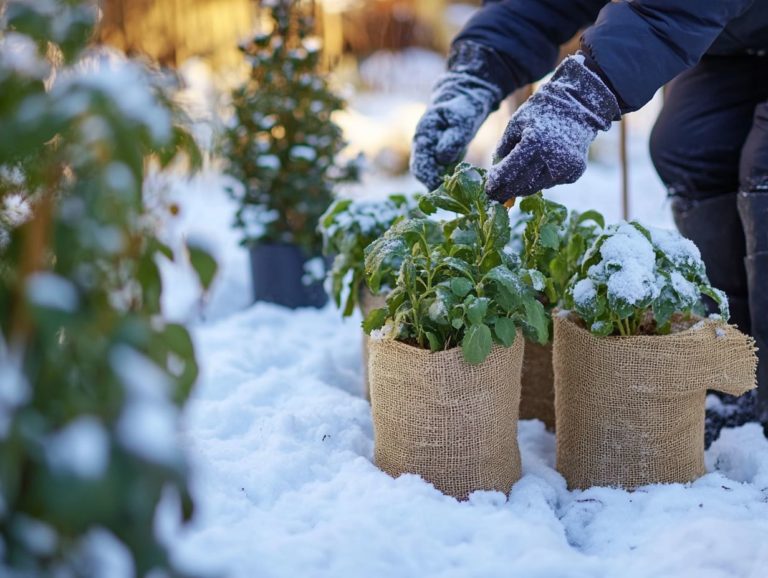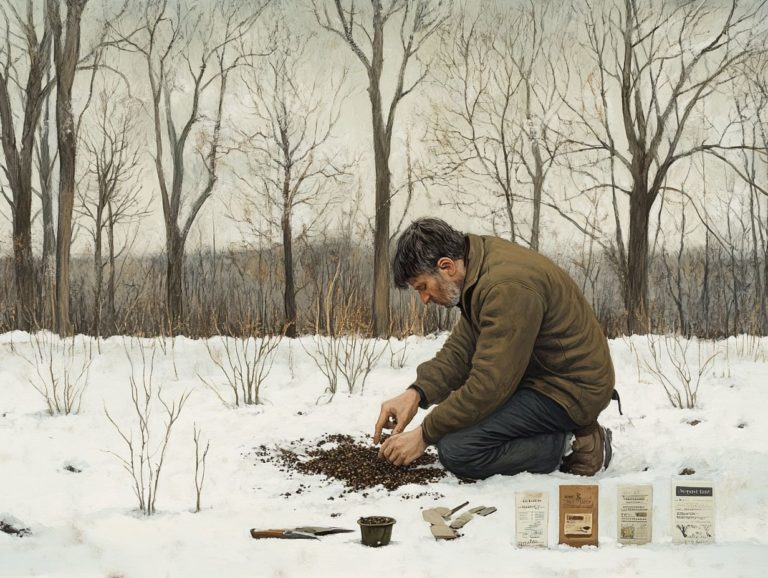Cover Crops: Winter Gardening Must-Haves
Cover crops are gardening’s best-kept secret! They serve an essential purpose in boosting soil health and fostering biodiversity.
In this article, you’ll explore what cover crops are and their myriad benefits. You’ll also discover the diverse varieties that flourish in winter gardens.
Uncover best practices for integrating these plants into your garden. Identify common pitfalls to avoid and learn effective solutions for any challenges that may arise.
Immerse yourself in this journey to see how cover crops can elevate your gardening experience!
Contents
- Key Takeaways:
- What are Cover Crops?
- Benefits of Cover Crops
- Types of Cover Crops
- How to Incorporate Cover Crops into Your Winter Garden
- Best Practices for Planting and Maintaining
- Common Mistakes to Avoid
- Frequently Asked Questions
- What are cover crops and why are they essential for winter gardening?
- What are some popular cover crop options for winter gardening?
- How do I choose the right cover crop for my winter garden?
- When should I plant cover crops for winter gardening?
- Do cover crops need special care during winter?
- Can cover crops be used in small gardens or containers?
Key Takeaways:
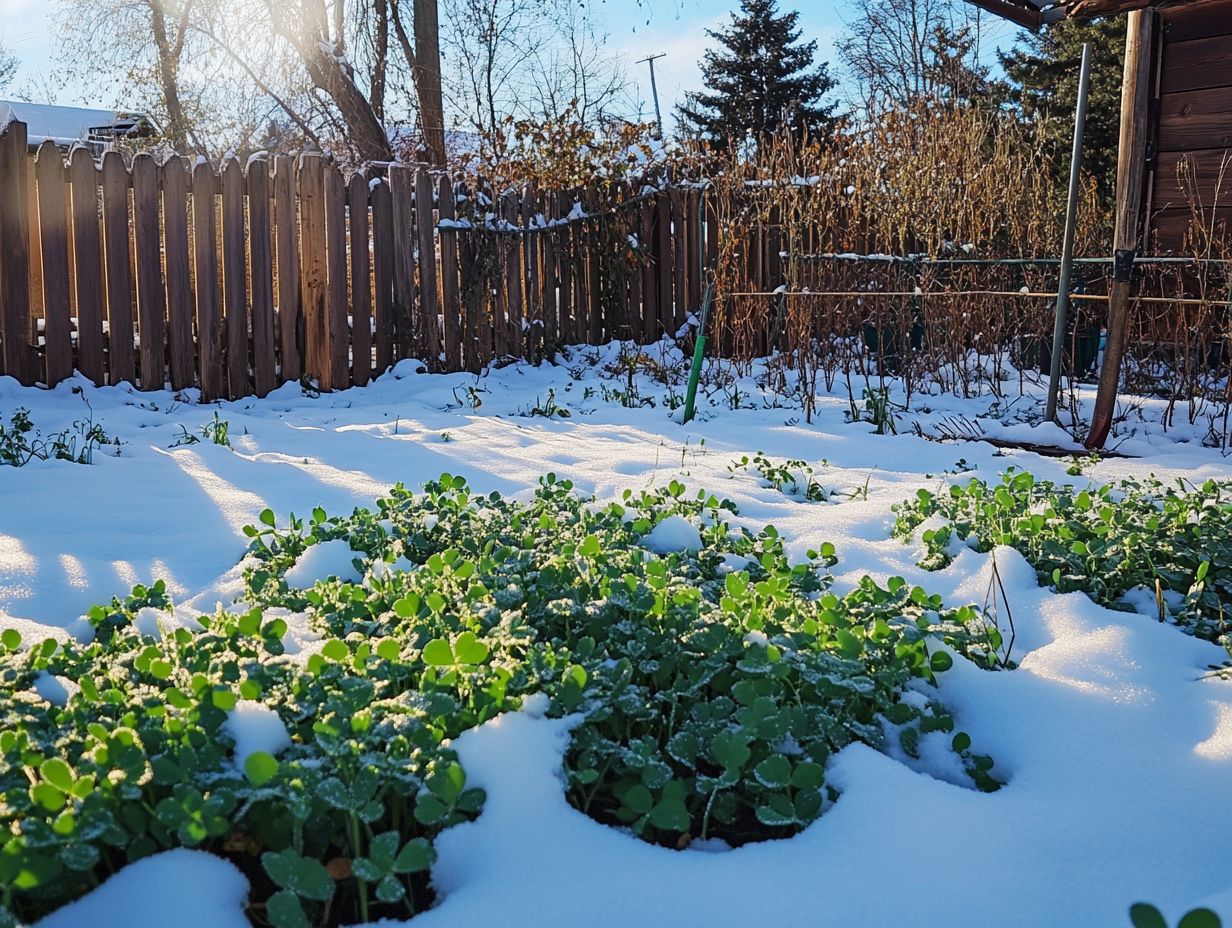
- Cover crops are plants grown specifically to benefit the soil and surrounding ecosystem, making them essential for a successful winter garden.
- Winter cover crops improve soil health, reduce erosion, and attract beneficial insects, making them a must-have in any winter garden.
- To incorporate cover crops into your winter garden, follow best practices for planting and maintenance. Avoid common mistakes like planting too late or not choosing the right crop for your soil and climate.
What are Cover Crops?
Cover crops are essentially your garden’s best friends. They are cultivated primarily to enrich the soil rather than for harvest.
In Virginia, farmers and gardeners use cover crops intentionally. This enhances soil fertility, improves soil structure, and manages nutrients.
Using cover crops leads to healthier garden soil and boosts food production, creating a thriving ecosystem right in your backyard.
Definition and Purpose
Cover crops are specialized plants cultivated in agricultural fields and vegetable gardens to enhance soil health. They also provide many ecological benefits.
These carefully selected plants are pivotal in sustainable agriculture. They improve soil structure and prevent erosion, covering the soil to reduce nutrient runoff.
Cover crops maintain essential moisture levels for nutrient retention. By integrating diverse varieties, such as legumes and brassicas, you can fix nitrogen and break up compacted soil layers. Additionally, using mulch to protect winter crops can further enhance your gardening efforts.
This practice enriches the soil and helps suppress weeds and pests, leading to healthier crops and increased yields.
By adopting cover crops, you create a robust and resilient farming system while actively contributing to environmental stewardship.
Benefits of Cover Crops
The advantages of utilizing cover crops significantly impact soil health and enhance crop yields. They benefit the entire agricultural ecosystem.
This is especially true in regions like Virginia, where there is a strong focus on sustainable practices.
Improving Soil Health
One of the most significant benefits of cover crops is their remarkable ability to enhance soil health. They boost organic matter, elevating soil fertility.
These crops serve as a natural remedy, adding valuable biomass through their robust root systems and decaying plant residues.
For example, legumes like clover enrich your soil with nitrogen and cultivate a diverse community of beneficial microorganisms. These microbes play a crucial role in making nutrients available.
Plants such as rye and hairy vetch contribute to organic matter buildup while effectively suppressing weeds and preventing erosion.
Cover crops interact with soil microbes, boosting nutrient availability and water retention. This leads to healthier and more productive soils for your garden!
Start incorporating cover crops into your garden today for immediate benefits! Share your thoughts or questions below and join our gardening community!
Reducing Erosion
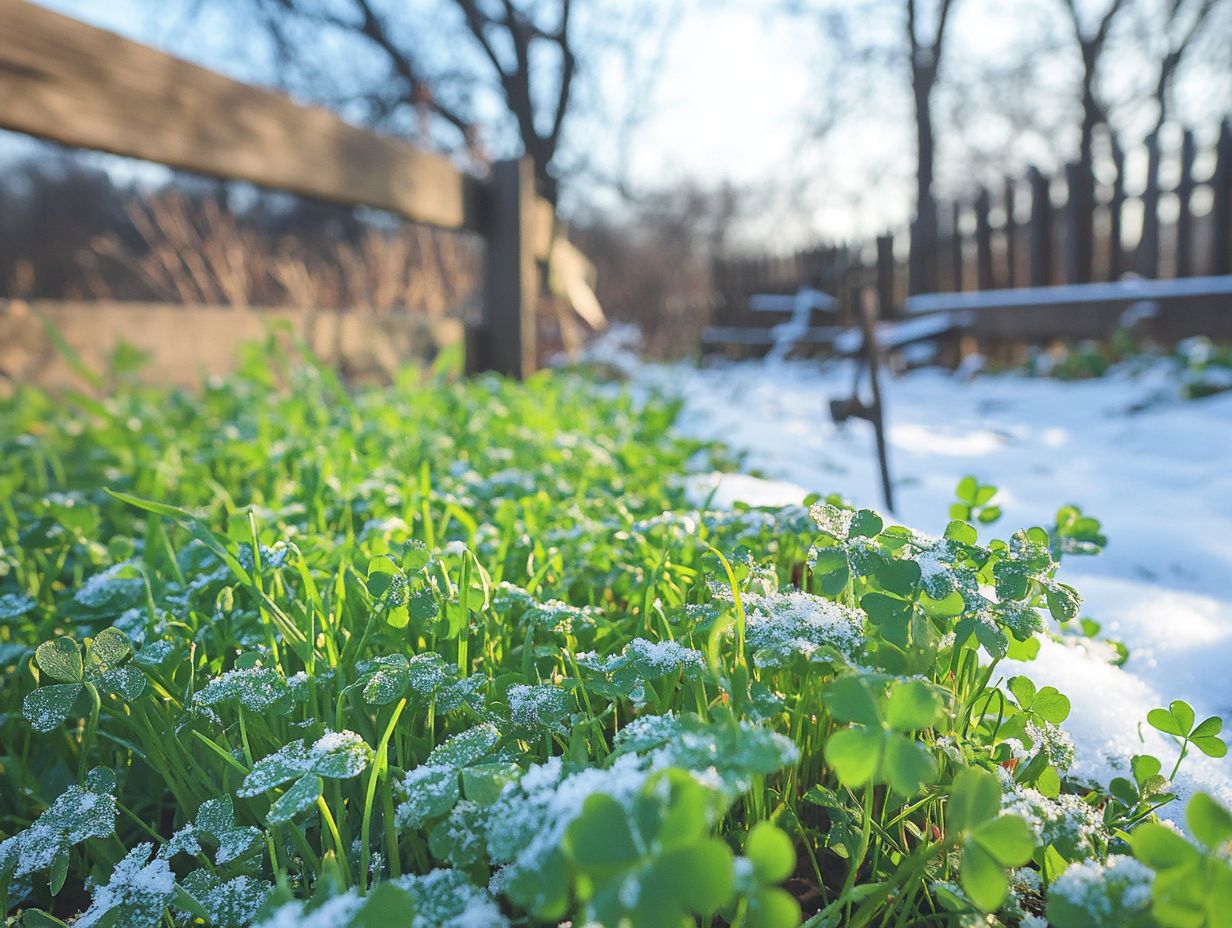
Cover crops serve a vital purpose in reducing soil erosion as they establish deep roots and provide biomass that helps stabilize the soil structure.
During the colder winter months, these plants create a protective barrier over your soil, effectively minimizing erosion from wind and water. Their deep roots anchor the top layers while enhancing soil porosity. This allows for improved water infiltration and prevents runoff, keeping the soil firmly in place and boosting its overall stability.
By maintaining a continuous cover, these crops enrich the soil with organic matter and foster a vibrant ecosystem that significantly contributes to sustainable farming practices.
Attracting Beneficial Insects
One of the standout advantages of cover crops is their remarkable ability to attract beneficial insects and pollinators, which are vital for the health of your vegetable garden.
These crops build a lush habitat that serves as a sanctuary for a diverse array of insects, including ladybugs, lacewings, and bees. Each of these insects plays a crucial role in pest control and pollination. By providing nourishing nectar and pollen, cover crops encourage these essential creatures to thrive, enriching the overall biodiversity of your gardening ecosystem.
This natural pest-management approach aligns seamlessly with sustainable agriculture practices, promoting a balanced environment where your plants can flourish without an overreliance on chemical fertilizers or pesticides. These diverse interactions lead to healthier crops and contribute to a more resilient agricultural landscape.
Types of Cover Crops
Cover crops can be classified into two main categories: winter and summer crops. Each type plays a distinct role in improving soil health and boosting agricultural productivity, offering valuable benefits tailored to the specific needs of your farming practices.
Winter Crops
Winter crops, like winter wheat and crimson clover, are cultivated to thrive in colder temperatures. Incorporating tips for sustainable winter gardening can enhance their benefits, as they play a significant role in retaining soil moisture and building organic matter.
These resilient plants endure frosty conditions and contribute greatly to enhancing soil fertility. For example, you can sow winter wheat in late October to early November in Virginia, which allows it to anchor the soil even during harsh weather. Similarly, when you plant crimson clover in the fall, you benefit because it helps add nitrogen to the soil, enriching it for the crops that follow.
By incorporating these winter varieties into your garden, you can enjoy improved soil health, reduced erosion, and a more resilient ecosystem come spring! For optimal results, consider using the best cover crops for cold-climate gardens. Regular maintenance, like checking moisture levels and managing weeds properly, will help you maximize the advantages of these hardy plants.
Summer Crops
Summer crops, particularly those used in cover cropping, play a vital role in maintaining soil moisture and enhancing soil structure throughout the growing season.
Beyond these key benefits, selecting summer cover crops like buckwheat, millet, and cowpeas can significantly boost biodiversity and keep pesky weeds at bay. These remarkable plants enrich the soil with organic matter through their robust root systems, releasing essential nutrients as they decompose.
Using effective crop rotation strategies (changing the type of crops grown in each season) that include summer cover crops can disrupt pest cycles and lower the risk of diseases. Timing is everything; planting these cover crops shortly after harvesting your main cash crop creates the ideal conditions for growth.
Employing good management practices, such as consistent monitoring and sufficient irrigation, further enhances their effectiveness, making a substantial contribution to overall soil health during the warmer months.
How to Incorporate Cover Crops into Your Winter Garden
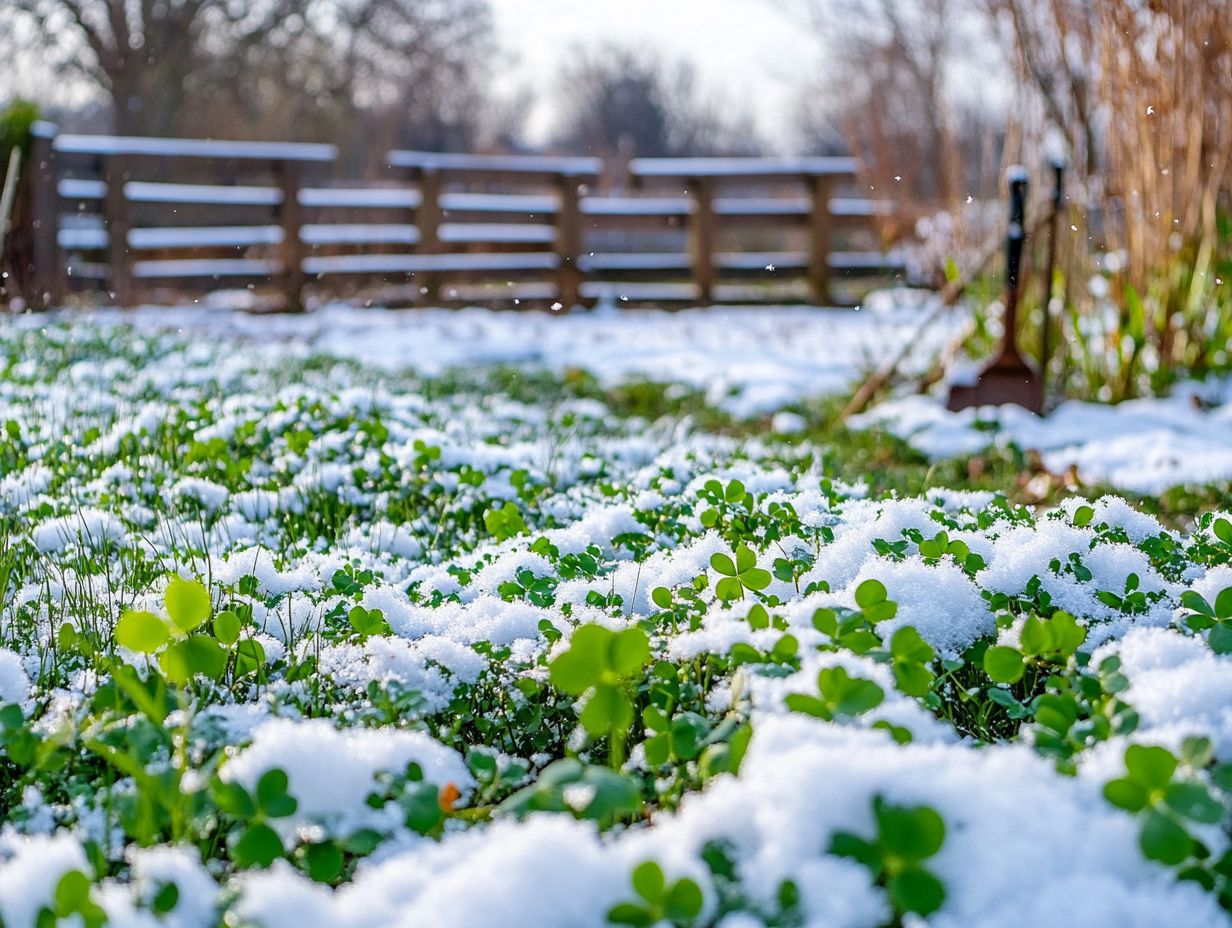
Incorporating cover crops into your winter garden requires thoughtful planning and a commitment to effective management techniques. To learn more about selecting the best options, don’t wait! Start planting the right winter cover crops today to protect your soil for the upcoming season!
Best Practices for Planting and Maintaining
Best practices for planting and maintaining cover crops revolve around selecting the right species, planting at the right time, and regularly monitoring soil compaction and health.
By focusing on these key elements, you can significantly enhance soil quality and promote biodiversity. It s crucial to consider your specific climate and soil conditions when choosing cover crop varieties, as some thrive better in certain environments than others.
Incorporating organic amendments, like compost or green manure, further enriches your soil ecosystem, providing essential nutrients for your crops. For optimal results, ensure proper seedbed preparation and employ crop rotation to bolster the effectiveness of your cover crops, enhancing resilience against pests and diseases.
Common Mistakes to Avoid
Common mistakes in cover cropping can undermine the benefits these plants provide for soil health and crop production. It s essential to understand these pitfalls and avoid them to fully enjoy the rewards of effective cover cropping.
Problems and Solutions
Problems with cover cropping can stem from various factors. Understanding the solutions is crucial for maintaining soil biology and enhancing crop productivity.
You may encounter challenges like pest invasions or nutrient deficiencies when integrating cover crops. Certain cover crops might attract pests that threaten your primary crops or may not provide the necessary nutrients, compromising soil health.
To tackle these issues, consider diversifying your cover crop selections. This approach creates a wonderful balance that can repel pests while boosting soil nutrient levels.
Applying organic matter and practicing crop rotation can significantly enhance soil fertility. These strategies address immediate concerns and foster healthier soil ecosystems, leading to improved agricultural outcomes and more sustainable farming practices.
Final Thoughts and Recommendations
Incorporating cover crops into your gardening experience beautifully aligns with sustainable agriculture goals while enhancing both soil health and productivity.
These amazing plants do incredible things for your soil preventing erosion, boosting organic matter, and playing a pivotal role in nutrient management by fixing nitrogen and suppressing pesky weeds. By integrating cover crops, you create a thriving ecosystem that supports beneficial insects and fosters biodiversity.
Follow these steps to integrate cover crops:
- Select the right cover crops tailored to your local climate and soil conditions.
- Sow them during the off-season for maximum benefit.
- Incorporate them into the soil before planting your main crops.
This approach nourishes your soil and optimizes your crop yields, making it a savvy strategy for any gardening endeavor.
Frequently Asked Questions
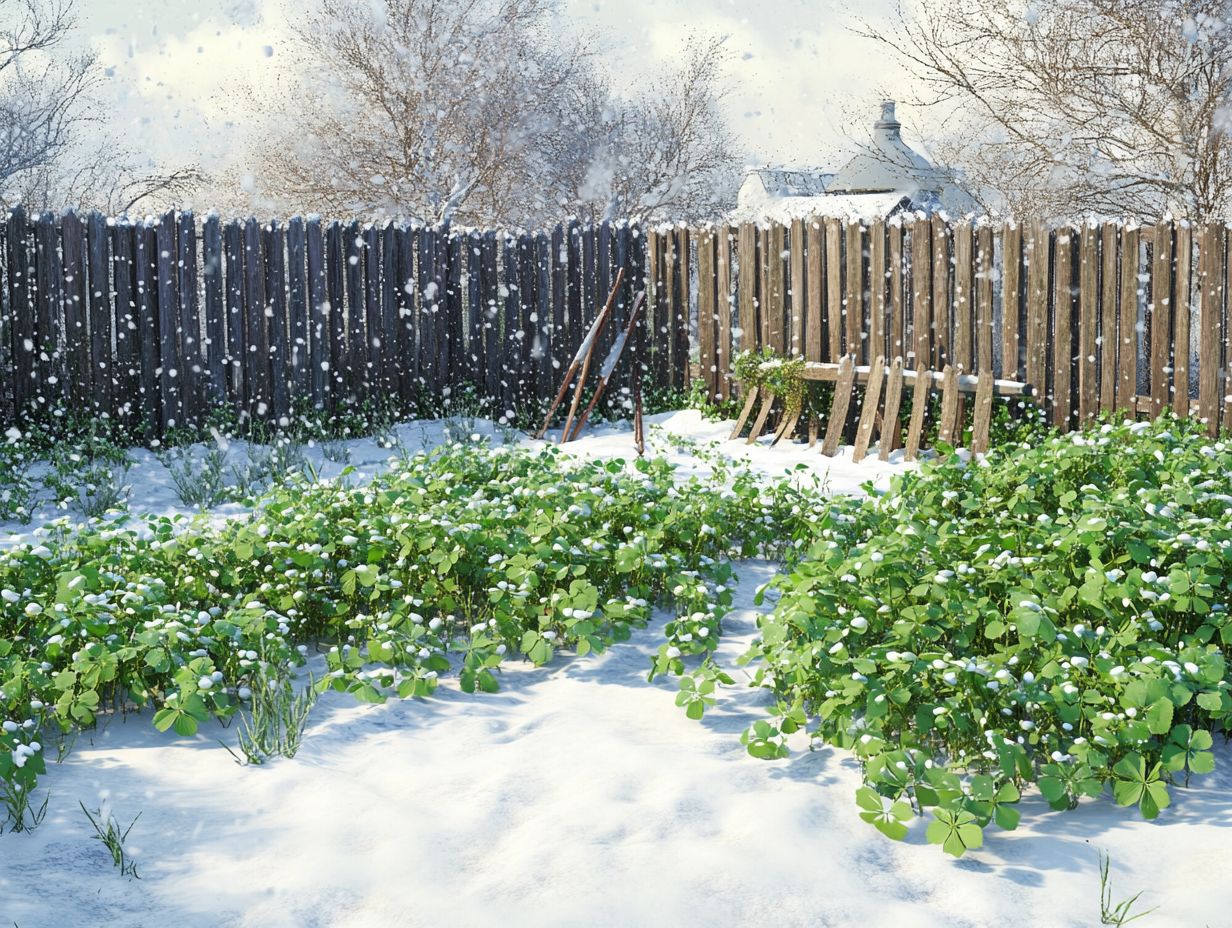
What are cover crops and why are they essential for winter gardening?
Cover crops are plants grown specifically to protect and improve the soil during colder months when the garden is not in use. To effectively prepare for winter gardening, consider the essential winter gardening supplies you need. They prevent soil erosion, add nutrients, and suppress weeds to prepare the soil for spring planting.
What are some popular cover crop options for winter gardening?
Popular cover crops for winter gardening include clover, rye, vetch, and winter peas. These plants are cold-tolerant and can withstand harsh winter conditions, making them key winter gardening supplies that every gardener should consider.
How do I choose the right cover crop for my winter garden?
The best cover crop for your winter garden depends on your climate, soil type, and the specific needs of your garden. Research different cover crop options and consider checking out essential tools for winter crop rotation or consulting a local gardening expert for personalized recommendations.
When should I plant cover crops for winter gardening?
Plant cover crops in late summer or early fall. This timing allows them to establish strong roots before winter arrives.
Do cover crops need special care during winter?
You’ll love how easy cover crops are to care for! They require minimal upkeep, but care varies by climate. In colder areas, you can enhance your gardening success by maximizing yield with top winter gardening techniques to protect them from frost and snow.
In milder regions, they may keep growing. You might need to mow or trim them to keep them manageable.
Can cover crops be used in small gardens or containers?
Absolutely! Cover crops work well in any garden size or even in containers. Choose varieties that fit your space.
Mixing different cover crops can yield the best results for your gardening needs.
Get started on your winter gardening today and enjoy the benefits of cover crops!



